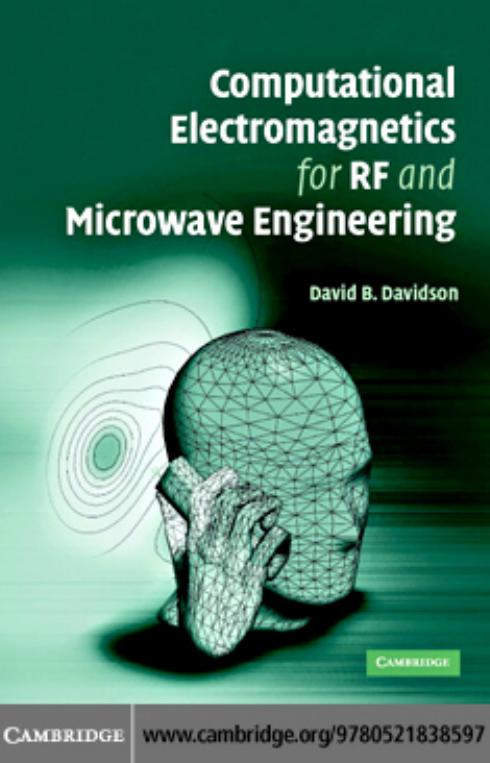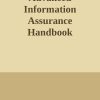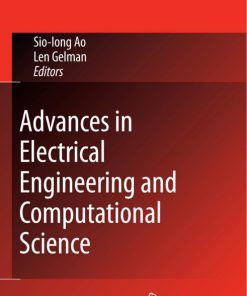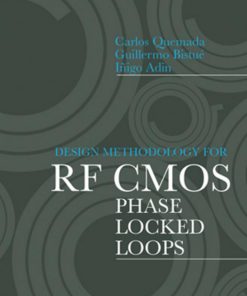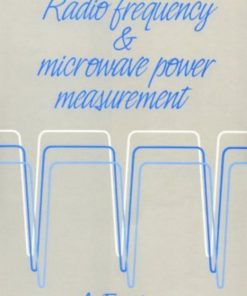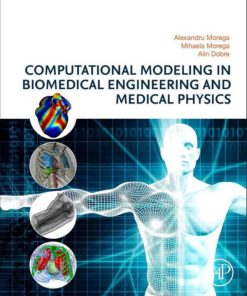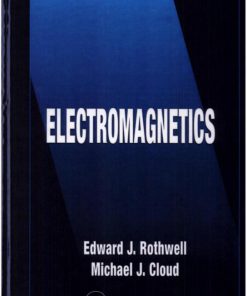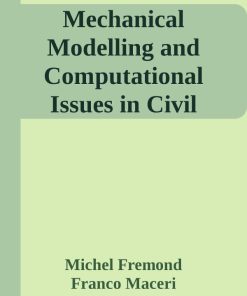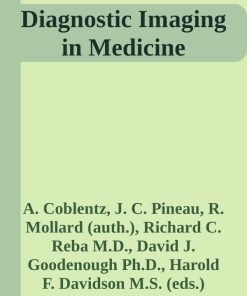Computational Electromagnetics for RF and Microwave Engineering 1st Edition by David Davidson ISBN 0511410980 9780511410987
$50.00 Original price was: $50.00.$25.00Current price is: $25.00.
Authors:DAVID B. DAVIDSON , Author sort:DAVIDSON, DAVID B. , Languages:Languages:eng , Published:Published:Jul 2008
Computational Electromagnetics for RF and Microwave Engineering 1st Edition by David Davidson – Ebook PDF Instant Download/Delivery. 0511410980, 9780511410987
Full download Computational Electromagnetics for RF and Microwave Engineering 1st Edition after payment

Product details:
ISBN 10: 0511410980
ISBN 13: 9780511410987
Author: David Davidson
Computational Electromagnetics for RF and Microwave Engineering 1st Table of contents:
1 An overview of computational electromagnetics for RF and microwave applications
1.1 Introduction
1.2 Full-wave CEM techniques
1.3 The method of moments (MoM)
1.4 The finite difference time domain (FDTD) method
1.5 The finite element method (FEM)
1.6 Other methods
1.6.1 Transmission line matrix (TLM) method
1.6.2 The method of lines (MoL)
1.6.3 The generalized multipole technique (GMT)
1.7 The CEM modelling process
1.8 Verification and validation
1.8.1 An example: a frequency selective surface
1.9 Extending the limits of full-wave CEM methods
1.10 CEM: the future
1.11 A “road map” of this book
References
2 The finite difference time domain method: a one-dimensional introduction
2.1 Introduction
2.2 An overview of finite differences
2.2.1 The basic solution procedure
2.2.2 Approximating derivatives using finite differences
2.3 A very brief history of the FDTD
2.4 A one-dimensional introduction to the FDTD
2.4.1 A one-dimensional model problem: a lossless transmission line
2.4.2 FDTD solution of the one-dimensional lossless transmission line problem
Summary: FDTD scheme for the model problem
Programming aspects: avoiding half-steps
Programming aspects: “in-place” operations
Programming aspects: reducing the “operation count”
Obtaining and evaluating preliminary results
2.4.3 Accuracy, convergence, consistency and stability of the method
2.5 Obtaining wideband data using the FDTD
2.5.1 The Gaussian pulse
2.5.2 The Gaussian derivative pulse
2.5.3 A polynomial pulse
2.5.4 The 1D transmission line revisited from a wideband perspective
2.5.5 Estimating the Fourier transform
2.5.6 Simulation using Gaussian and Gaussian derivative pulses
2.6 Numerical dispersion in FDTD simulations
2.6.1 Dispersion
2.6.2 Derivation of the dispersion equation
2.6.3 Some closing comments on dispersion in FDTD grids
2.7 Conclusion
References
3 The finite difference time domain method in two and three dimensions
3.1 Introduction
3.2 The 2D FDTD algorithm
3.2.1 Electromagnetic scattering problems
3.2.2 The TEz formulation
3.2.3 Including a source: the scattered/total field formulation
3.2.4 Meshing the scatterer
3.2.5 Absorbing boundary conditions
3.2.6 Developing the simulator
Implementing the update equations
Implementing the plane-wave source
Implementation of the ABC
3.2.7 FDTD analysis of TE scattering from a PEC cylinder
3.2.8 Computational aspects
3.3 The PML absorbing boundary condition
3.3.1 An historical perspective
3.3.2 A numerical absorber – pre-Berenger
3.3.3 Berenger’s split field PML formulation
3.3.4 The FDTD update equations for a PML
3.3.5 PML implementation issues
3.3.6 Results for a split field PML
3.3.7 Drawbacks of the Berenger PML
3.3.9 Stretched coordinate theory
3.3.10 Further reading on PMLs
3.3.11 Conclusions on the PML
3.4 The 3D FDTD algorithm
3.5 Commercial implementations
3.5.1 An introductory example – a waveguide “through”
3.5.2 A waveguide filter
3.5.3 A microstrip patch antenna
3.6 Further reading
3.7 Conclusions
References
4 A one-dimensional introduction to the method of moments: thin-wire modelling
4.1 Introduction
4.2 An electrostatic example
4.2.1 Some simplifying approximations
4.2.2 Approximating the charge
4.2.3 Collocation
4.2.4 Solving the system of linear equations
4.2.5 Results and discussion
4.3 Thin-wire electrodynamics and the MoM
4.3.1 The electrically thin dipole
Approximating the current
The incident field
Some computed results
4.3.2 A caveat regarding thin-wire formulations
4.4 More on basis functions
4.4.1 The numerical electromagnetic code (NEC) – method of moments
4.4.2 NEC basis functions
4.4.3 Piecewise linear basis functions
4.4.4 Junction treatments with piecewise linear basis functions
4.5 The method of weighted residuals
4.6 Further reading
4.7 Conclusions
References
5 The application of the FEKO and NEC-2 codes to thin-wire antenna modelling
5.1 Introductory comments
5.2 An introductory example: the dipole
5.3 A wire antenna array: the Yagi–Uda antenna
5.4 A log-periodic antenna
5.5 An axial mode helix antenna
5.6 A Wu–King loaded dipole
5.7 Conclusions
References
6 The method of moments for surface modelling
6.1 Electric and magnetic field integral equations
6.2 The Rao–Wilton–Glisson (RWG) element
6.3 Some examples of surface modelling
6.3.1 Scattering from a sphere
6.3.2 The analytical solution
6.4 Modelling homogeneous material bodies using equivalent currents
6.5 Scattering from a dielectric sphere
6.6 Computational implications of surface and volume modelling with the MoM
6.7 Hybrid MoM/asymptotic techniques for large problems
6.7.1 Introduction
6.7.2 Moment method/asymptotic hybrids
6.7.3 Physical optics and MoM hybridization
6.7.4 A FEKO example using the MoM/PO hybrid
6.8 Other approaches for the solution of electromagnetically large problems
6.8.1 Background
6.8.2 High-performance computing
6.8.3 FFT-based methods
6.8.4 The fast multipole method
A two-dimensional FMM prototype
The full three-dimensional FMM
6.9 Further reading
6.10 Concluding comments
References
7 The method of moments and stratified media: theory
7.1 Introduction
7.2 Dyadic Green functions: some introductory notes
7.3 A static example of a stratified medium problem: the grounded dielectric slab
7.4 The Sommerfeld potentials
7.4.1 A brief revision of potential theory
7.4.2 The Sommerfeld potentials
Preliminaries
The spectral domain transform
Normal component representation
Sommerfeld potentials
7.4.3 An example: derivation of Gxx A for single-layer microstrip
7.4.4 The scalar potential and the mixed potential integral equation
7.4.5 Surface waves
7.5 Evaluating the Sommerfeld integrals
7.5.1 Approximate evaluation of the Sommerfeld integrals
7.5.2 Numerical integration in the spectral domain
7.5.3 Locating the pole
7.5.4 General source locations
7.5.5 Some results for the Sommerfeld potentials
7.6 MoM solution using the Sommerfeld potentials
7.7 Further reading
References
8 The method of moments and stratified media: practical applications of a commercial code
8.1 Printed antenna and microstrip technology: a brief review
8.2 A single patch antenna
8.3 Mutual coupling between microstrip antennas
8.4 An array with “scan blindness”
8.5 A concluding discussion of stratified media formulations
References
9 An introduction to the finite element method
9.1 Introduction
9.2 Variational and Galerkin weighted residual formulations: the Laplace equation
9.2.1 The weighted residual approach
9.2.2 The variational approach
The equivalent variational functional
Manipulating the energy term
Connecting the elements
9.2.3 Some practical issues: assembling the system
Connecting the system
Handling the boundary conditions
9.2.4 More on variational functionals
Summary of boundary conditions
Boundary conditions at material interfaces
9.2.5 The Poisson equation: incorporating a source term
9.2.6 Discussion
9.3 Simplex coordinates
9.3.1 Simplex coordinates in one, two and three dimensions
9.3.2 Some properties of simplex coordinates
9.4 The high-frequency variational functional
9.5 Spurious modes
9.6 Vector (edge) elements
9.6.1 An historical perspective
9.6.2 Theory of vector elements
9.6.3 Vector elements on triangles – the Whitney element
9.7 Application to waveguide eigenvalue analysis
9.7.1 The two-dimensional variational functional for homogeneous waveguide
9.7.2 Explicit formula for the elemental matrix entries
9.7.3 Coding
Edge and node numbering schemes
Meshing
Book-keeping
Solving the eigenvalue problem
Post-processing
9.7.4 Results
9.8 The three-dimensional Whitney element
9.9 Further reading
9.10 Conclusions
References
10 A selection of more advanced topics on the finite element method
10.1 Higher-order elements
10.1.1 Complete versus mixed-order elements
10.1.2 Hierarchal vector basis functions
10.1.3 Properties of hierarchal basis functions
10.1.4 Practical impact of higher-order basis functions in an FEM code
10.2 The FEM from the variational boundary value problem viewpoint
10.3 A deterministic 3D application: waveguide obstacle analysis
10.3.1 Introduction
10.3.2 The waveguide formulation
Formulation overview
Computation of the S-parameters
The waveguide formulation: another perspective
10.4 Application to two waveguide discontinuity problems
10.4.1 Application to a Magic-T
Introduction
Setting up the problem
Conclusions
10.4.2 Application to a capacitive iris
A rationale for complete basis functions
Results
Discussion
10.5 Hybrid finite element/method of moments formulations
10.5.1 Introduction
10.5.2 Theoretical background
10.6 An application of the FEM/MoM hybrid – GSM base stations
10.6.1 Applications of FEM/MoM hybrid formulations
10.6.2 Human exposure assessment near GSM base stations
10.7 The time domain FEM
10.7.1 Basic formulation and implementation
Basic finite element formulation
Time integration
10.7.2 Preliminary results
10.7.3 The FDTD method as a special case of the FETD
10.8 Sparse matrix solvers
10.8.1 Profile-in skyline storage
10.8.2 Compressed row storage
10.8.3 Implementation of matrix solution using these storage schemes
10.8.4 Results for sparse storage schemes
10.9 A posteriori error estimation and adaptive meshing
10.9.1 Explicit, residual-based error estimators
10.9.2 An example of the application of an error estimator
10.10 Further reading and conclusions
References
Appendix A The Whitney element
Appendix B The Newmark-β time-stepping algorithm
References
Appendix C On the convergence of the MoM
Reference
Appendix D Suggested exercises and assignments
Chapter 2
1D FDTD analysis
Chapter 3
2D FDTD analysis
3D FDTD analysis
Partial solution
Chapter 4
1D MoM analysis
Chapter 5
Application of FEKO and NEC-2
Chapter 6
2D MoM analysis and hybrid methods
Chapter 7
Sommerfeld potentials
Chapter 8
Practical application of the Sommerfeld potentials
Chapter 9
2D finite elements
Chapter 10
Advanced FEM topics
Reference
Appendix E Useful formulas for simplex coordinates
Basic properties
People also search for Computational Electromagnetics for RF and Microwave Engineering 1st:
computational electromagnetics for rf
computational electromagnetics for rf and microwave engineering pdf
electromagnetic field formula
unit of electromagnetic field
computational electromagnetics reddit

